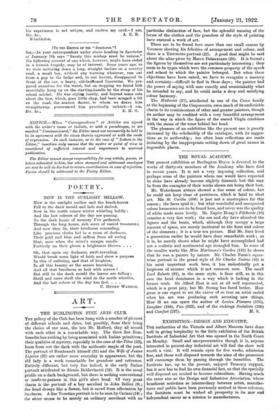THE. ROYAL ACADEMY.
THE present exhibition at Burlington House is devoted to the works of thirty-six members of the Academy who have died in recent years. It is not a very imposing collection, and perhaps some of the painters whom one would have expected to shine have already become slightly dimmed, but this may be from the examples of their works shown not being their best.
Mr. Waterhouse always showed a fine sense of colour, but he could not keep clear of prettiness, which is fatal to ideal art. His St. Cecilia (100) is just not a masterpiece for this reason ; the faces spoil it ; but what wonderful and unexpected colour harmonies are to be found here, and never was the quality of white made more lovely. Mr. Napier Hemy's Pilchards (10) remains a very fine work ; the sea and sky have absorbed the figures and the boats, which, although they occupy a large amount of space, are merely incidental to the form and colour of the elements ; it is a true sea picture. Had Mr. Sant lived a generation earlier he would have done remarkable work ; as it is, he merely shows what he might have accomplished had not a realistic and sentimental age strangled him. In some of the smaller works like Miss Martineau's Garden (110) he shows that he was a painter by nature. Mr. Charles Fume's eques- trian portrait in the grand style of Sir Charles Nairne (48) is his most important work here, it has undoubtedly got a largeness of manner which is not common now. The small Lord Roberts (91), in the same style, is finer still, as in this case the head dominates in a way which is lacking in the former work. Sir Alfred East is not at all well represented, which is a great pity, but Mr. Strang has fared better. How great is our regret to see the career of so true an artist ended when his art. was producing such arresting new things. How ill we can spare the author of Lucien Pissarro (170), Laughter (194), Pan (222), and of the etchings Socialists (336)


































 Previous page
Previous page